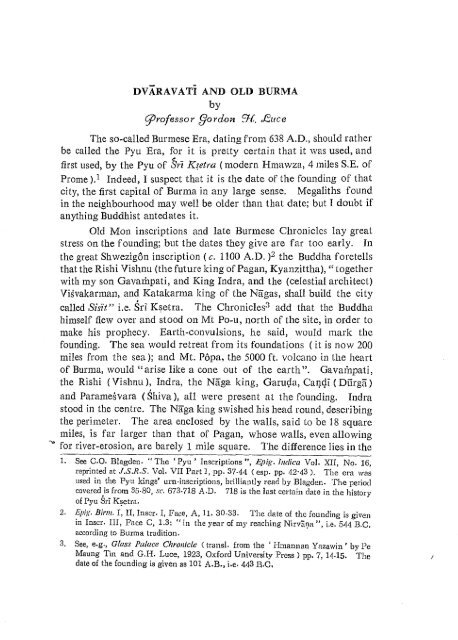The Journal of the Siam Society Vol. LIII, Part 1-2, 1965 - Khamkoo
The Journal of the Siam Society Vol. LIII, Part 1-2, 1965 - Khamkoo
The Journal of the Siam Society Vol. LIII, Part 1-2, 1965 - Khamkoo
You also want an ePaper? Increase the reach of your titles
YUMPU automatically turns print PDFs into web optimized ePapers that Google loves.
DVARAV A Ti AND OLD BURMA<br />
by<br />
r]Jr<strong>of</strong>esso r §o rdon r:H . .£.uce<br />
<strong>The</strong> so-called Burmese Era, dating from 638 A.D., should ra<strong>the</strong>r<br />
be called <strong>the</strong> Pyu Era, for it is pretty certain that it was used, and<br />
first used, by <strong>the</strong> Pyu <strong>of</strong> Sr"i K~etra (modern Hmawza, 4 miles S.E. <strong>of</strong><br />
Prome ).1 Indeed, I suspect that it is <strong>the</strong> date <strong>of</strong> <strong>the</strong> founding <strong>of</strong> that<br />
city, <strong>the</strong> first capital <strong>of</strong> Burma in any large sense. Megaliths found<br />
in <strong>the</strong> neighbourhood may well be older than that date; but I doubt if<br />
anything Buddhist antedates it.<br />
Old Mon inscriptions and late Burmese Chronicles lay great<br />
stress on <strong>the</strong> founding; but <strong>the</strong> dates <strong>the</strong>y give are far too early. In<br />
<strong>the</strong> great Shwezigon inscription (c. 1100 A.D. ) 2 <strong>the</strong> Buddha foretells<br />
that <strong>the</strong> Rishi Vishnu (<strong>the</strong> future king <strong>of</strong> Pagan, Kyanzittha), "toge<strong>the</strong>r<br />
with my son Gavarhpati, and King Indra, and <strong>the</strong> (celestial architect)<br />
Visvakarman, and Katakarma king <strong>of</strong> <strong>the</strong> Nagas, shall build <strong>the</strong> city<br />
called Siszt" i.e. Sri Ksetra. <strong>The</strong> Chronicles 3 add that <strong>the</strong> Buddha<br />
himself flew over and stood on Mt Po-u, north <strong>of</strong> <strong>the</strong> site, in order to<br />
make his prophecy. Earth-convulsions, he said, would mark <strong>the</strong><br />
founding. <strong>The</strong> sea would retreat from its foundations (it is now 200<br />
miles from <strong>the</strong> sea); and Mt. Popa, <strong>the</strong> 5000 ft. volcano in <strong>the</strong> heart<br />
<strong>of</strong> Burma, would "arise like a cone out <strong>of</strong> <strong>the</strong> earth". Gavainpati,<br />
<strong>the</strong> Rishi (Vishnu), Indra, <strong>the</strong> Naga king, Garur;la, Caqqi ( Di1rga)<br />
and Paramesvara ( Shiva ), all were present at <strong>the</strong> founding. Indra<br />
stood in <strong>the</strong> centre. <strong>The</strong> Naga king swished his head round, describing<br />
<strong>the</strong> perimeter. <strong>The</strong> area enclosed by <strong>the</strong> walls, said to be 18 square<br />
miles, is far larger than that <strong>of</strong> Pagan, whose walls, even allowing<br />
~ for river-erosion, are barely 1 mile square. <strong>The</strong> difference lies in <strong>the</strong><br />
1. See C.O. Blagden. "<strong>The</strong> 'Pyu' Inscriptions", Epig. Indica <strong>Vol</strong>. XII, No. 16,<br />
reprinted at J.S.R.S. <strong>Vol</strong>. VII <strong>Part</strong> l, PP· 37-44 ( esp. pp. 42-43 ). <strong>The</strong> era was<br />
used in <strong>the</strong> Pyu kings' urn-inscriptions, brilliantly read by Blagden. <strong>The</strong> period<br />
covered .is from 35·80, sc. 673-718 A.D. 718 is <strong>the</strong> last certain date in <strong>the</strong> history<br />
<strong>of</strong> Pyu Sri K9etra.<br />
2. Epig. Birm. I, II, Inscr. I, l'ace, A, ll. 30-33. <strong>The</strong> elate <strong>of</strong> <strong>the</strong> founding is given<br />
in Inscr. III, l'ace C, 1.3: "in <strong>the</strong> year <strong>of</strong> my reaching Nirv'a1~a ", i.e. 544 B.C.<br />
according to Burma tradition.<br />
3. See, e.g., Glass Palace Chronicle (trans!. from <strong>the</strong> ' Hmannan Yazawin' by Pe<br />
Maung Tin and G.H. Luce, 1923, Oxford University Press) pp. 7, 14-15. <strong>The</strong><br />
date <strong>of</strong> <strong>the</strong> founding is given as 101 A.B., i.e. 443 B.C,

















